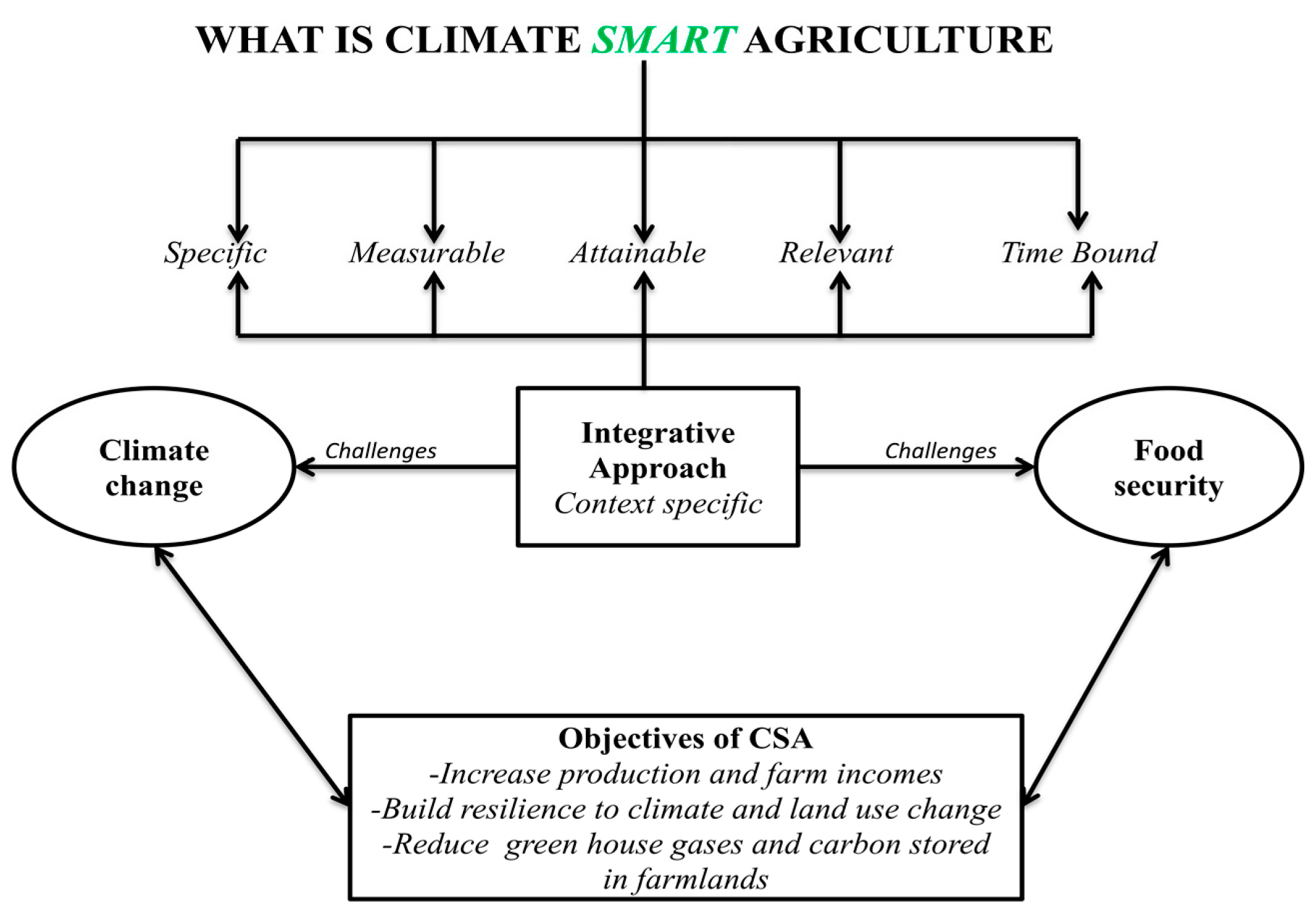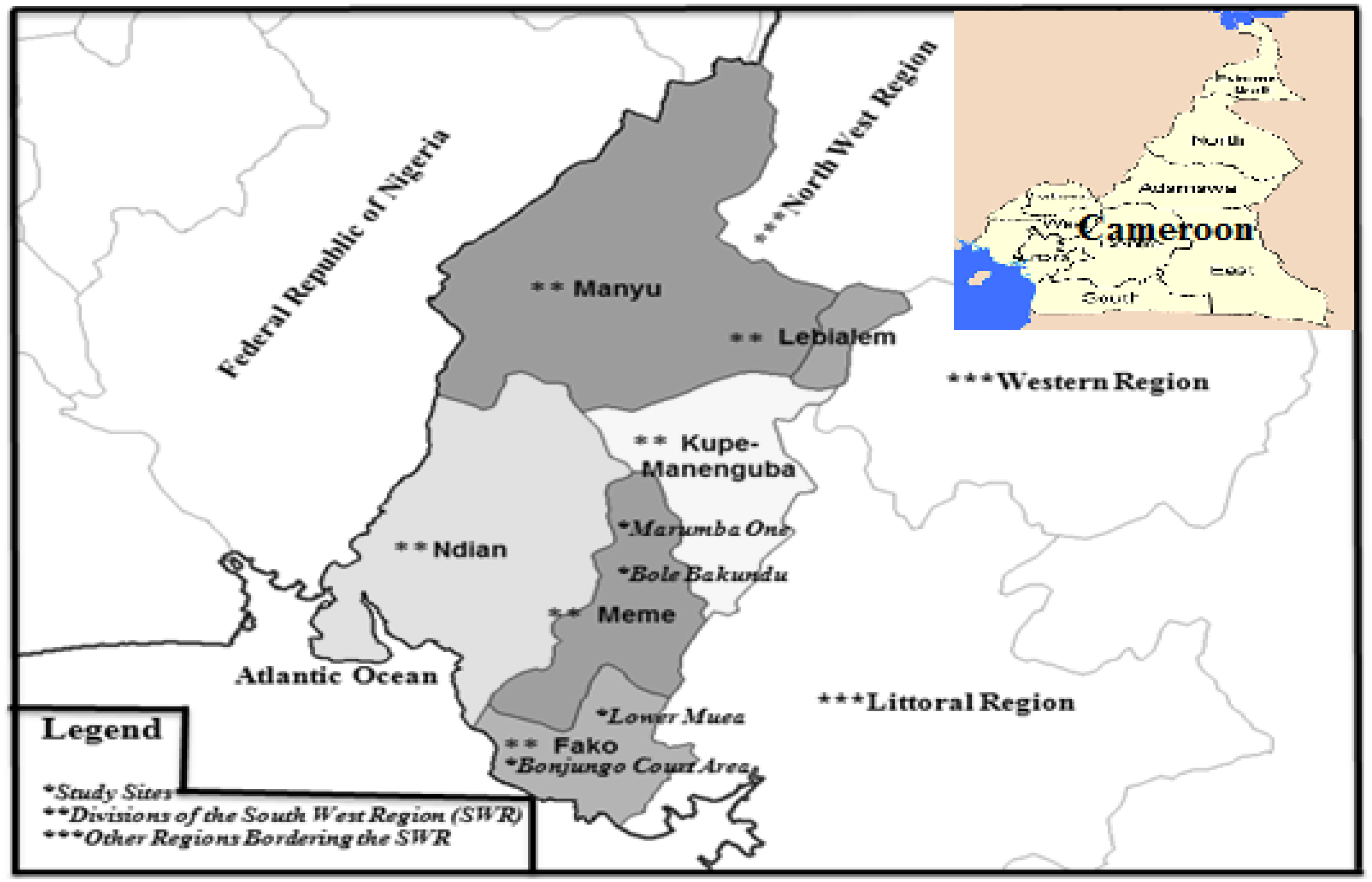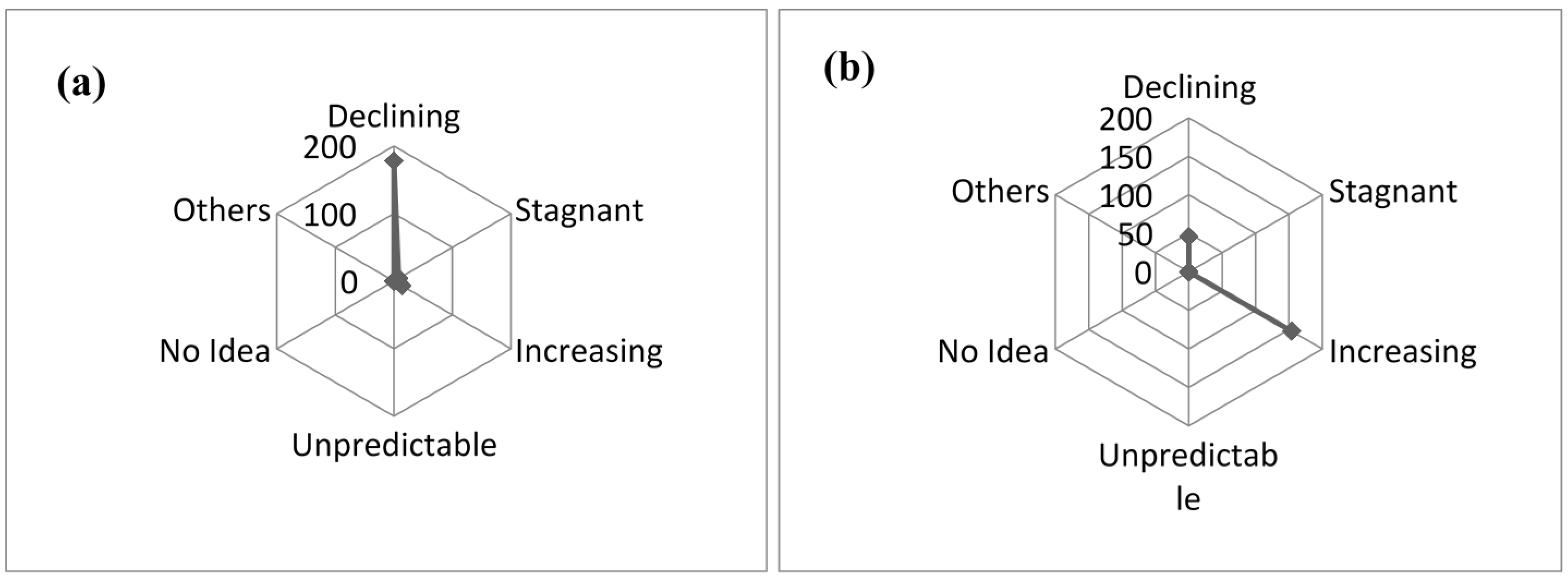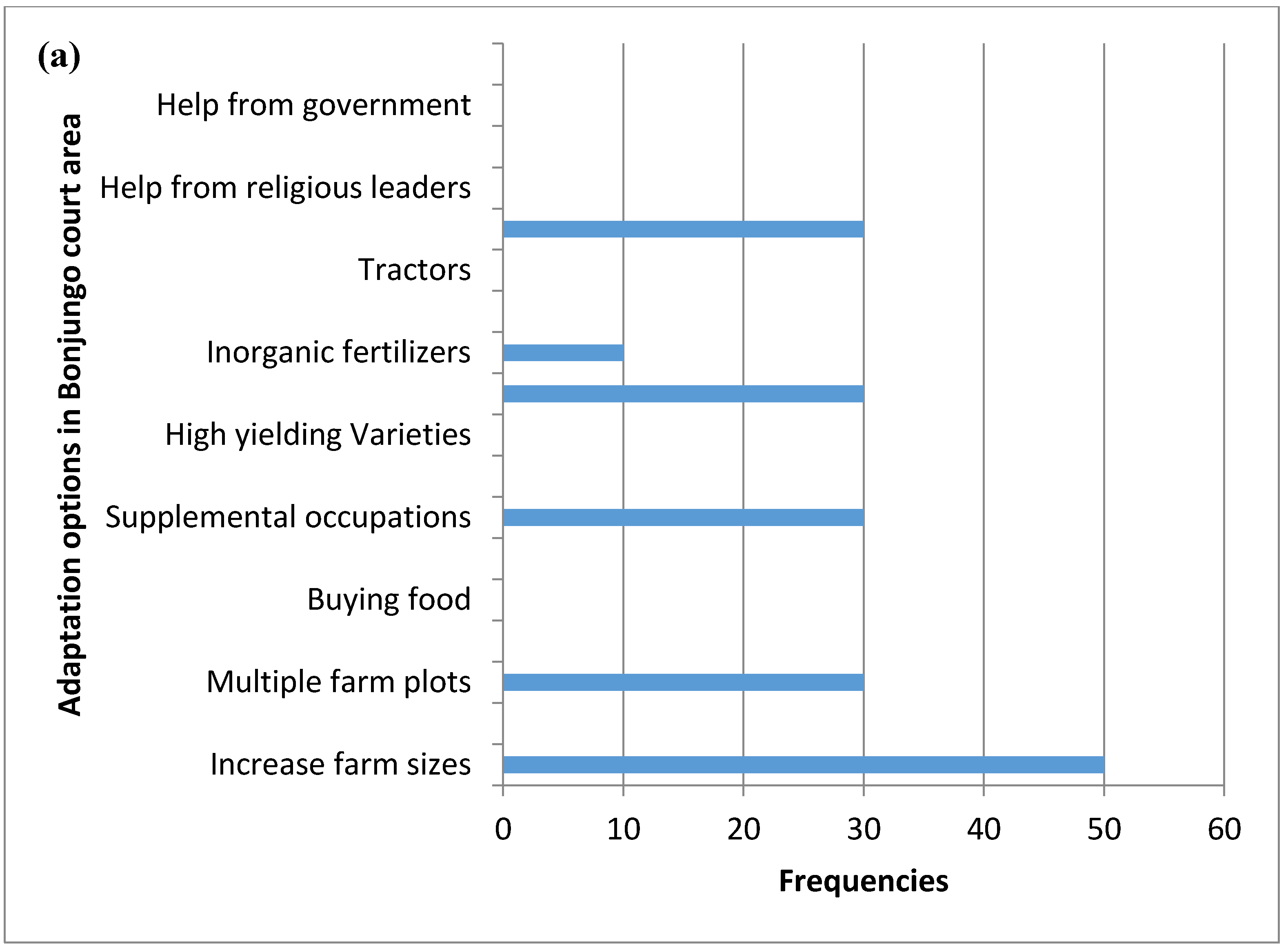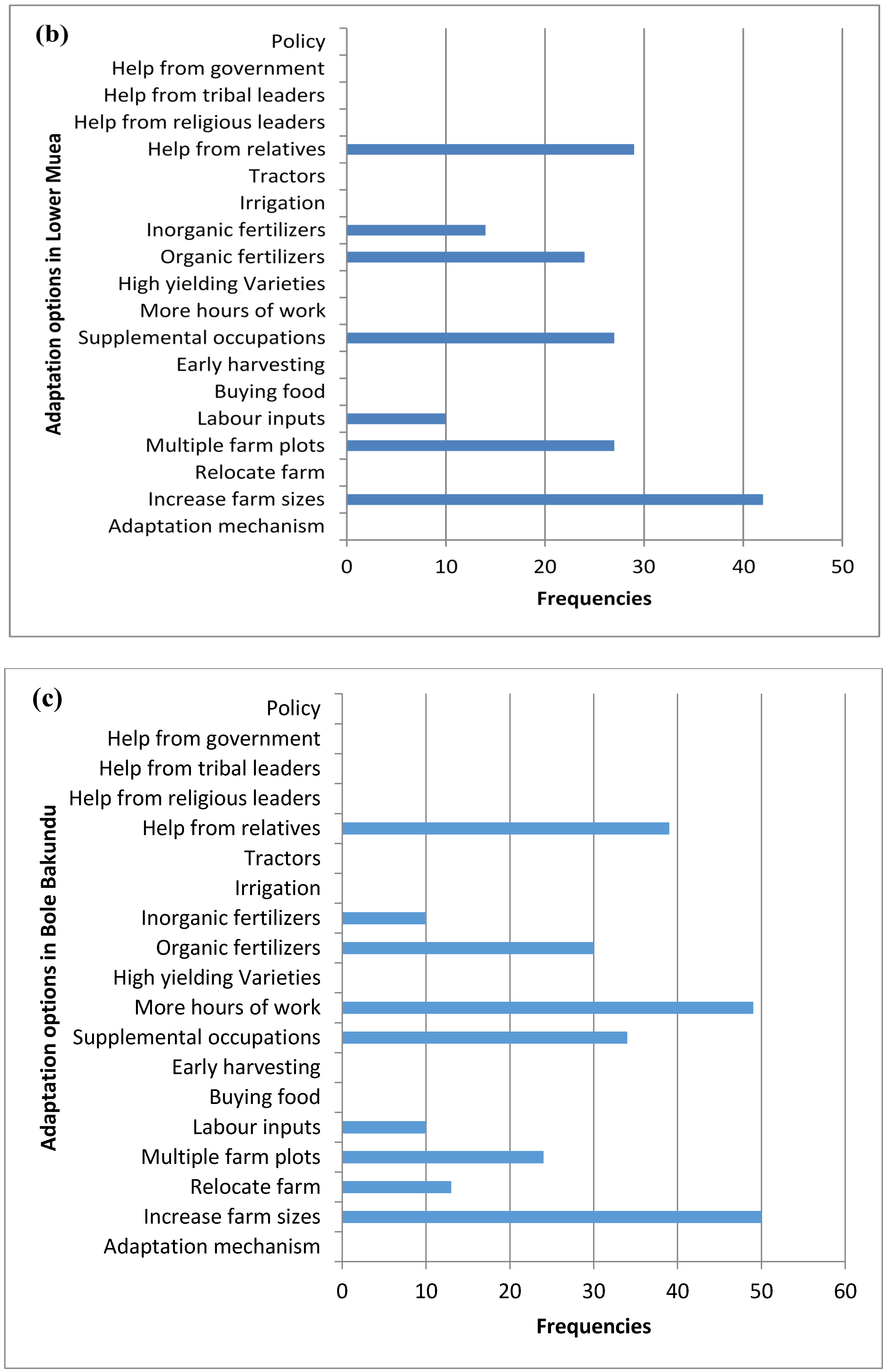1. Introduction
In Cameroon, the agricultural sector and related food processing activities account for about 50% of export earnings, contribute about 30% to the GDP and employ between 70%–80% of the population [
1]. The agrarian population in Cameroon is made up of essentially small-scale peasant farmers and their family members who make up about 70% of the agricultural population [
2].
The majority of farmers in Cameroon are small-scale peasant farmers and they are responsible for the production of about 80% of the country’s food crops. In the face of an increasing population, the use of farm inputs that are not environmentally sustainable, and wide-scale agricultural and forest land use changes, food crop production trends seem to be uncertain or rather stagnant as studies report that projected/expected needed crop production is often above actual production [
3,
4]. A study by Epule
et al. [
4] argued that, between 1975 and 2005, there were 20 years during which actual cereal production in Cameroon were persistently below projected/expected needed cereal production levels. Yengoh
et al. [
5] verified the role of land management practices and the socio-cultural properties of small-scale farmers in establishing differences in crop yields. In addition, Epule
et al. [
6] verified the vulnerability of experiencing food shortages along gender and poverty lines.
Several authors have argued that, as in most sub-Saharan African countries, Cameroon is currently experiencing declines or stagnation in food production at a national scale [
7,
8]. Some studies have attributed this decline to poor soil nutrient conditions [
8,
9,
10], while more recent empirical and model based analyses have attributed the declines to global environmental change related variables such as population growth and the inherent expansion of agricultural land through forest clearance/deforestation, which results in reduced soil organic carbon and nitrogen, essential elements in crop growth [
7,
11]. Other potential causes of the decline are: poor governance, inadequate access to farm inputs such as fertilizers, increasing economic opportunities elsewhere, and a breakdown of cultural practices. A lot of efforts are being made to increase crop yields and reduce food insecurity. One such effort is geared towards adjusting food production systems to adapt to the environmental changes through various adaptation strategies.
Agricultural adaptation requires a consideration of both human and physiographic challenges that are responsible for environmental change in specific contexts. In the context of this study, this has to do with the physiographic and human oriented drivers of food insecurity listed above. In as much as indigenous knowledge remains vital, dealing with the drivers of food production stagnation will also involve comprehensive and dynamic policy changes [
12]. Climate Smart Agriculture (CSA) offers an integrative approach to adaptation within the context of agriculture that involves services to farmers and farm activities with the intention of creating greater resilience of farming systems in the face of environmental change and reducing the environmental foot-prints. CSA can be regarded as a set of integrative approaches that are used to increase agricultural productivity while at the same time making agriculture sustainable. CSA is not a set of practices but a set of approaches that must be context-specific. CSA was coined by the Food and Agricultural Oranization of the United Nations (FAO) in 2010 following the Hague conference on food security, agriculture and climate change. CSA aims to: increase food production, increase the resilience of farming systems to environmental change and increase the sustainability of agricultural systems through reduced Green House Gases (GHGs) and environmental foot-prints emanating from agriculture. The options for CSA must be like the word, “SMART” itself
i.e., S for Specific, M for Measurable, A for Attainable, R for Relevant, T for Time-Bound (
Figure 1). CSA often involves two main elements: (1) services to farmers such as policies, financing and institutional arrangements and (2) land management options that aim at conserving ecosystem services. As such, the prospects of CSA for scientific management will be based on these two elements.
The main purpose of this study is to determine whether small-scale farming crop yields are declining or not and to verify the existing adaptation options used based on indigenous knowledge in the specific study sites. However, this study has three main objectives: (1) to verify the perceptions of the local peasant farmers on existing trends and projections as to whether crop yields were increasing, declining or stagnant between 2010 and 2014 (current yields) and in the past decade (2000 and 2010), (2) to verify the perceptions of the local peasant farmers with respect to current indigenous adaptation options used. Indigenous adaptation here reflects the different adaptation options that are used by the local farmers, and (3) to discuss the areas of CSA that can be adopted by the local farmers in establishing meaningful adaptation options in the study area. To the best of our knowledge, this is the first time such analyses have been performed on these specific study sites and at this scale. As noted above already, there are studies that have already identified that at a national scale there are food production declines, but these have not been verified in the different agro-eco-regions of Cameroon. As such, this finer-scale analysis fills in a major gap by identifying whether there are variations in yields, what the drivers of this are and whether they vary across space, and most importantly what this means for adaptation (i.e., how context-specific does adaptation need to be?).
4. Discussion
The assertion that arable production is declining in the current study sites is consistent with several other studies. Faced with increasing population, less sustainable farm inputs, and wide-scale land use changes in the forestry sector, Cameroon has witnessed crop production stagnation as projected needed crop production is said to be above actual production [
3,
6]. A study carried out in the drier north of Cameroon by Epule
et al. [
6] argued further that, between 1975 and 2005, there were 20 years during which actual cereal production was persistently below projected needed cereal production. Following the FGDs, the common reasons for the decline in yields in all four study sites included: wide-scale deforestation through slash and burn fires, out migration of working populations to urban areas, lack of access to farm inputs such as inorganic fertilizers, limited understanding of how to valorize organic fertilizers, and inadequate implementation of government policies protecting the agricultural sector.
In most of Africa, access to basic farm inputs is often scarce due to poverty, and farmers tend to resort to farmland expansion as a means of increasing their yields. It is often believed that the more land that is brought under production, the greater the yields. While this is true to a certain extent, it is also common knowledge that, at a certain threshold, the more new land that is brought under production, the more likely is the potential to observe diminishing returns to scale. To make things worse, this option will soon become obsolete due to large scale deforestation in favour of farmland, and the fact that less and less land is becoming available in most of Africa for continued arable production expansion. In the related literature, it has been argued that the expansions of permanent croplands as well as pasture land are common strategies used in adaptation to food production declines. It is suggested that when crop and pasture land areas increase, food production and supply will increase since more hectares will brought under cultivation [
7]. Using statistical approaches, Epule
et al. [
6] have shown that there is a perfect positive correlation between food production in Africa and the expansion of permanent cropland; they obtained a correlation coefficient of 0.86 and a coefficient of determination of 0.87 between food production and cropland expansion. The latter study states further that, in Africa, permanent cropland increased by 64% (14,868 thousand hectares), from 27,122 thousand hectares in 1961 to 41,990 thousand hectares in 2000. This reasoning has been supported further by arguments that African food policy has for a long time been anchored on the expansion of farmland [
16]. Rosegrant and Cline [
17] argued that the expansion of agricultural land is one means of boosting up production that is sufficient in meeting rising demands for food. The process of increasing land in order to cultivate more crops is not necessarily sustainable environmentally. This is why it has been argued that arable and permanent cropland expansion in Cameroon to enhance crop production has been described as the second most viral cause of deforestation [
17].
It has also been verified that the expansion of farmland is often associated with increases in production in the short run and reductions in the long run. For example, an empirically grounded model, based on a study by Epule and Bryant [
18], found that the expansion of maize production land in Cameroon led to increased maize production in the short run but a reduction in the amount of maize produced in the long run. They argued that expansion of farmland in the short run provides more land for cultivation but in the long run, the area that has been deforested for this expansion becomes susceptible to all types of erosion and low soil nutrient storage and consequent reductions in soil organic carbon and nitrogen. While most farmers continue to depend on expanding farmland to increase production in most of Africa, this method of adapting agricultural systems to declines in production has been presented in many studies as one of the main problems of food security in Africa [
17,
18,
19,
20,
21]. To make a bad case worse, the prospects of expanding farmland further in most of Africa are gradually diminishing as less and less land is becoming available [
17]. In Africa, Asia and Latin America, 96% of forest area loss is as a result of agricultural expansion [
20,
21,
22,
23,
24,
25]. Farmland expansion stands out as the most important indigenous adaptation option in all the four study sites considered in this study. This can be explained by the fact that the local farmers do not have access to other methods of expanding production such as high capital intensive equipment and inorganic fertilizers and therefore depend on the only available resource; that is, land to produce more. As presented already, it is believed that the more land you use for production, the higher your yields, but, in the long run, such expansion would rather reduce production due to inadequacies in soil organic carbon and nitrogen and high levels of erosion.
In addition, farmers in Africa also depend a lot on family labour to enhance production. The average family is composed of the father, the mother and at least three to four children. The more members a family has, the more the family is said to have assets because family labour is often a major source of agricultural labour in mainly poor communities in the developing world in which access to modern techniques of adaptation such as tractors and high yielding varieties are lacking. Unfortunately, the productivity of family labour is often limited in that it can often increase yields only to a certain threshold beyond which stagnation results. This is one of the reasons why, in spite of these measures, the study sites still experience stagnation in production. Djurfeldt
et al. [
17] noted that food production in most of Africa is labour intensive and capital extensive, meaning most farmers in Africa depend on the labour of their family members or dependents due to limited access to capital equipment such as tractors.
Many of the farmers are involved in other activities aside from crop production in a bid to absorb the shocks associated to declining yields. These have been described as supplemental occupations. In the study sites, some farmers have resorted to a diversification of their livelihood by not depending only on crop production. This option is good because during periods of stagnation or declines in yields, the farmers can rely on their supplemental occupations. Common options used here as declared during the FGDs include the rearing of livestock such as cane rats, goats, rabbits and poultry. Others depend on small businesses such as sole proprietor shops in the neighbourhoods that sell basic household utilities. Supplemental occupations are very important in various natural resource management decisions. In the literature, it has been argued that one way of making sure that communities dependent on natural resources absorb the shocks in cases of declines in their resources is through the diversification of livelihoods or integrating other activities into their main activities. For example, gatherers and farmers may diversify their livelihoods by rearing cane rats, goats and rabbits that can supplement the income lost from their regular activities as gatherers and farmers. In forestry, for example, one way of stopping the indigenous population from cutting trees is through supplemental occupations or diversification of livelihood activities through the provision of credits, cash or other incentives that can help farmers take up tree crop planting as a means of subsistence. In this way, they do not have to resort to logging to satisfy their basic financial or fuel wood needs [
26,
27,
28,
29,
30,
31]. Diversification of livelihoods—also called livelihood planning—has been described as one of the most important socio-economic methods of absorbing the shocks involved in environmental resource decline by Le
et al. [
32]; it reduces the degree of dependence on farming and gathering by providing alternatives for the local populations. The diversification of livelihoods also involves a more systematic change in resource allocation such as targeted diversification of production systems and livelihoods [
32,
33].
In terms of the use of organic fertilizers, many farmers use this as a natural system of adaptation in the face of declining yields. Based on the FGDs, many of the farmers resort to the use of food wastes and composts because they are unable to procure inorganic fertilizers. In as much as this method is good for the environment, the current levels of valorization of organic substances in most of Africa and the four study sites remains low, and it has been argued that organic fertilizers can only increase yields to a certain threshold or level beyond which outputs will remain constant unless they are combined with inorganic fertilizers. A study carried out in Kabate, Central Kenya, examines the effects of soil management in the context of the effects of organic and inorganic inputs on soil biomass and productivity and confirms the argument that the current levels of organic manure usage in most of Africa cannot sustain production [
31,
32,
34,
35]. It has been argued that organic resources alone are often unable to provide sufficient nutrients to maintain long-term nutrient resource bases for agriculture [
34,
35]. Therefore, the best case scenarios of nutrient provision are when both organic and inorganic fertilizers are used at the same time [
34,
36]. In relation to this, the prospects of organic manure or agro-ecology methods are seen as methods that cannot stand on their own to sustain yields. This of course is linked to the fact that the systems have not been well developed and valorized as is the case in countries like Gambia and Malawi.
This study has found that the main adaptation approaches used by farmers to enhance production in the four study sites are: expansion of farmland, help from relatives and other dependents, supplemental occupations and use of organic fertilizers. So far, as seen in the results above, it can be said that most of the farmers depend more on problem solving mechanisms than on the social-support mechanisms with the exception of help from relatives. The role of policy, government, tribal and religious leaders appears to be weak based on the population perceptions. Therefore, adherence to CSA as a means of enhancing agricultural production is essential. CSA can be regarded as a set of integrative approaches that are context specific and used to combat the challenges of climate change and increase food security. CSA is not a set of practices but a set of approaches that fit specific contexts. CSA involves two main elements; these include:
services to farmers and
land management options (on the farm
) that aim at conserving ecosystem services. From this perspective, the prospects of CSA for science management will be based on these two elements that are discussed in detail below (
Figure 1).
In the area of
farm management or on-the-farm options, a number of sub-categories can be identified. The first component has to do with the
quantification of farm inputs. This category involves the quantification of farm inputs through the amount of fertilizers that farmers can apply on their farms which may well prevent crops from perishing because of too little or too many fertilizers. The hand-held green seeker (Trimble Navigation limited, Folsom, CA, USA) is a device that can be used to attain this objective. This is a device that calculates the Normalized Difference Vegetation Index (NDVI) which is a proxy for plant health, vigor and fertilizers need levels. The advantage here is that the farmers will be able to know the fertilizer requirements for their crops by placing the device over their crops; this avoids a situation in which farmers just apply fertilizers without knowing the actual plant fertilizer requirements. Governments and extension services can help to borrow or rent out these devices to the farmers. The second on-the-farm option involves
investments in agroforestry and mixed farming. Trees can increase above ground biomass, provide litter and enhance soil organic content as well as enhance soil organic carbon and nitrogen which are very vital for crop yields [
37]. Globally, about 1.2 billion people are using agroforestry methods in their farms [
38]. In integrating trees into farms, the farmers have to be careful; the types of trees to be planted should be indigenous fruit trees [
39] that have implications on planting decisions which are also impacted by socio-cultural values [
40], market, food and the medicinal value of trees [
33]. Examples of such trees may include: pawpaw, cocoa, coffee, avocado, mango, cashew and banana,
etc. These are trees that produce fruits that can be eaten and sold [
41]. Mixed cropping on the other hand involves the growing of crops and keeping of animals. A true opportunity for agroecology here is that the trees benefit from the droppings of the animals as manure while the wastes from the crops serve as food to the animals or are used to produce compost, a real opportunity for agroecology and diversification of livelihoods [
42]. The last on-the-farm option has to do with
the valorization of agroecology through the following pathways: (1) natural control of diseases and pests through the use of nets and predator-prey strategies rather than the use of chemicals; (2) accumulation of organic matter and nutrient cycling through the use of natural processes; (3) improvement of biological interactions, biodiversity and synergies; and (4) conservation of resources such as water, soil, biodiversity and energy.
The services to farmers involve a network of actors and stakeholders that will finally impact adaptation policies. At the fore of this, we have farmers who have excellent indigenous knowledge based on their experience in farming for several years and they have basic indigenous techniques used in combating stagnation. This is exactly what this study has been able to verify via the actual perceptions of the farmers in relation to the actual techniques of adaptation used. In addition, learning and training schemes could also go a long way to enhance adaptation. This should provide the farmers with the basic skills needed, for instance, to interpret climate data and understand why their planning dates have to be changed and why the planting species have to be changed. In addition, financial mechanisms such as Reduction of Emissions from Deforestation and Forest Degradation (REDD+) should be placed at the disposal of the farmers. Such initiatives would enhance farmers’ participation in agroforestry since the financial benefits will become obvious. The challenge here is how to get the funds down to the right farmers in a society where corruption is rife. Another component of this section has to do with the carrying out of evidenced based research which should be anchored on scenarios and forecasting, all driven by data on variables such as growing season rainfall, temperatures, and land use change inter alia. Such evidence-based research will directly impact adaptation policies as well as the third component which involves climate change variability and sowing information. Media outlets could develop slots and programs in which such information on planting dates and sowing species are determined. Cell phone companies could also enhance the information sharing process by updating farmers with all this information.
